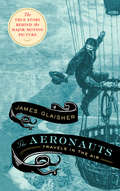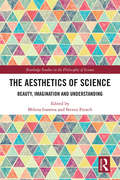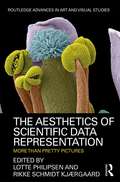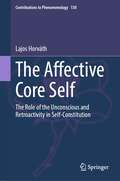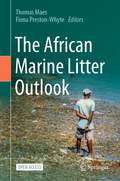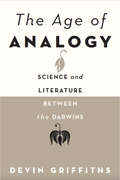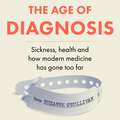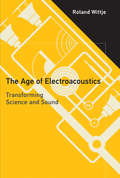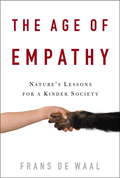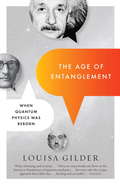- Table View
- List View
The Aeronauts: Travels in the Air
by James GlaisherThe True Story Behind the Major Motion Picture — and one of the greatest daredevil stories in the history of aviationIn 1862, ambitious scientist James Glaisher set out to do the impossible: ascend higher into the skies than ever before. A pioneer of weather forecasting and of photography, and a founding member of the Royal Meteorological Society, he wanted to take ground-breaking research measurements from different altitudes. On 5th September, along with experienced balloonist Henry Coxwell as his pilot, he lifted off in a hot air balloon for what would prove to be a death-defying and historic flight. Rising above the English countryside, they rose to the remarkable height of 37,000 feet (7 miles or 11km), almost killing both men, who experienced blurred vision, loss of motor function and, eventually, unconsciousness. It was a miracle they survived to tell the tale. Written in his own words, The Aeronauts chronicles Glaisher’s incredible flights and discoveries first hand, as well as his observations on those pioneers who came before and inspired him. His audaciously daring journey forms the story of the forthcoming major motion picture The Aeronauts. With an introduction by Professor Liz Bentley, Chief Executive at the Royal Meteorological Society
The Aesthetic Politics of Far-right Environmentalism
by Imogen RichardsThis book offers a groundbreaking exploration of the complex relationships between aesthetics, politics, and environmental concerns within far-right movements. Drawing on critical theory and insights from Walter Benjamin, Jacques Rancière, and others, it examines how both institutional far-right political parties and extra-institutional extremist actors manipulate environmental narratives to advance their distinct political agendas. Its unique approach features a comparative analysis of far-right individuals and organisations, investigating how they use imagetic media to promote ethnonationalist and authoritarian responses to environmental degradation, including the adverse effects of climate change. Spanning recent historical and contemporary contexts, the book provides a nuanced account of how eco-fascist and other far-right political ecologies are embedded within broader far-right ideologies. It critically analyses various dimensions of this alignment, including the romanticisation of nature as national identity, the instrumentalisation of ecological crises to justify authoritarian, anti-immigration, and other forms of social control, and the use of conservation rhetoric as a façade for nativist policies. It offers a broad overview of how images and other visual media are used for propaganda. This book will be of interest to policymakers, scholar-activists, and practitioners.
The Aesthetics of Science: Beauty, Imagination and Understanding (Routledge Studies in the Philosophy of Science)
by Steven French Milena IvanovaThis volume builds on two recent developments in philosophy on the relationship between art and science: the notion of representation and the role of values in theory choice and the development of scientific theories. Its aim is to address questions regarding scientific creativity and imagination, the status of scientific performances—such as thought experiments and visual aids—and the role of aesthetic considerations in the context of discovery and justification of scientific theories. Several contributions focus on the concept of beauty as employed by practising scientists, the aesthetic factors at play in science and their role in decision making. Other essays address the question of scientific creativity and how aesthetic judgment resolves the problem of theory choice by employing aesthetic criteria and incorporating insights from both objectivism and subjectivism. The volume also features original perspectives on the role of the sublime in science and sheds light on the empirical work studying the experience of the sublime in science and its relation to the experience of understanding. The Aesthetics of Science tackles these topics from a variety of novel and thought-provoking angles. It will be of interest to researchers and advanced students in philosophy of science and aesthetics, as well as other subdisciplines such as epistemology and philosophy of mathematics.
The Aesthetics of Scientific Data Representation: More than Pretty Pictures (Routledge Advances in Art and Visual Studies)
by Rikke Schmidt Kjærgaard Lotte PhilipsenHow can cartoon images aid in understanding bacterial biological processes? What prompts physicists to blur their images before showing them to biologists? Considering that the astronomer’s data consists solely of invisible, electric impulses, what is the difference between representing outer space as images, graphs, or sound? How does a work of contemporary art differ from a scientific image if we cannot visually distinguish between the two? How do aesthetics, art, and design influence scientific visualization and vice versa? This volume asks critically important questions about scientific data representation and provides significant insights to a field that is interdisciplinary in its very core. The authors investigate scientific data representation through the joint optics of the humanities and natural sciences. The volume particularly appeals to scholars in visual and aesthetic studies, data visualization, scientific illustration, experience culture, information design, and science communication.
The Aesthetics of Scientific Experiments (Routledge Studies in the Philosophy of Science)
by Milena Ivanova Alice MurphyThe relationship between aesthetics and science has begun to generate substantial interest. However, for the most part, the focus has been on the beauty of theories, and other aspects of scientific practice have been neglected. This book offers a novel perspective on aesthetics in experimentation via ten original essays from an interdisciplinary group comprised of philosophers, historians of science and art, and artists. The collection provides an analysis of the concept of beauty in the evaluation of experiments. What properties do practicing experimenters value? How have the aesthetic properties of scientific experiments changed over the years? Secondly, the volume looks at the role that aesthetic factors, including negative values such as ugliness, as well as experiences of the sublime and the profound, play in the construction of an experiment and its reception. Thirdly, the chapters provide in-depth historical case studies from the Royal Society, which also allows for a study of the depiction of scientific experiment in artworks, as well as contemporary examples from the LHC and cases of AI-designed experiments. Finally, it offers a exploration of the commonalities between how we learn from experiments on the one hand, and the cognitive value of artworks on the other. The Aesthetics of Scientific Experiments will be of interest to researchers and advanced students working in philosophy and history of science, and philosophy and history of art, as well as practicing scientists.
The Affective Core Self: The Role of the Unconscious and Retroactivity in Self-Constitution (Contributions to Phenomenology #130)
by Lajos HorváthThis book extends the contemporary concept of the minimal self by introducing the affective core self. The overall aim is to integrate certain psychoanalytical ideas into the phenomenological investigation of passivity and reformulate the idea of the phenomenological unconscious. This volume contributes to the multidimensional analysis of the self by positioning the affective core self between the layers of the more minimal and the less minimal self. It underscores the importance of the unconscious in the constitution of the affective core self by providing the comparative analysis of the phenomenological and the psychoanalytical unconscious.Furthermore, comparisons are drawn between Freud’s conception of the afterwardsness of trauma and the phenomenological notion of retroactive sense-constitution. The book concludes that retroactive sense-making is a double-sided phenomenon and differentiates between implicit-bodily and conscious-narrative retroactive sense-constitution. In order to bolster the idea of implicit-bodily sense-constitution the volume also examines and utilizes contemporary insights on the nature of body memory. The conclusion claims that the affective core self is constituted in time by means of the underlying processes of the two-sided retroactive sense-constitution. This text appeals to students and researchers working in phenomenology and philosophy of mind.
The African Marine Litter Outlook
by Thomas Maes Fiona Preston-WhyteThis open access book provides a cross-sectoral, multi-scale assessment of marine litter in Africa with a focus on plastics. From distribution, to impacts on environmental and human health, this book looks at what is known scientifically. It includes a policy analysis of the instruments that currently exist, and what is needed to help Africa tackle marine litter—including local and transboundary sources. Across 5 chapters, experts from Africa and beyond have put together a summary of the scientific knowledge currently known about marine litter in Africa. The context of the African continent and future projections form a backdrop on which the scientific knowledge is built. This scientific knowledge incorporates quantities, distributions, and pathways of litter into the marine environment, highlighting where the impacts of marine litter are most felt in Africa. These impacts have widespread effects, with ecological, social, economic, and human health repercussions. While containing detailed scientific information, this book provides a sound knowledge base for policymakers, NGOs and the broader public.
The Afterlives of Animals: A Museum Menagerie
by Samuel J. AlbertiIn the quiet halls of the natural history museum, there are some creatures still alive with stories, whose personalities refuse to be relegated to the dusty corners of an exhibit. The fame of these beasts during their lifetimes has given them an iconic status in death. More than just museum specimens, these animals have attained a second life as historical and cultural records. This collection of essays--from a broad array of contributors, including anthropologists, curators, fine artists, geographers, historians, and journalists--comprises short "biographies" of a number of famous taxidermized animals. Each essay traces the life, death, and museum "afterlife" of a specific creature, illuminating the overlooked role of the dead beast in the modern human-animal encounter through practices as disparate as hunting and zookeeping. The contributors offer fresh examinations of the many levels at which humans engage with other animals, especially those that function as both natural and cultural phenomena, including Queen Charlotte's pet zebra, Maharajah the elephant, and Balto the sled dog, among others. Readers curious about the enduring fascination with animals who have attained these strange afterlives will be drawn to the individual narratives within each essay, while learning more about the scientific, cultural, and museological contexts of each subject. Ranging from autobiographical to analytical, the contributors' varying styles make this delightful book a true menagerie. Contributors: Samuel J. M. M. Alberti, Royal College of Surgeons * Sophie Everest, University of Manchester * Kate Foster * Michelle Henning, University of the West of England, Bristol * Hayden Lorimer, University of Glasgow * Garry Marvin, Roehampton University, London * Henry Nicholls * Hannah Paddon * Merle Patchett * Christopher Plumb, University of Manchester * Rachel Poliquin * Jeanne Robinson, Glasgow Museums * Mike Rutherford, University of the West Indies * Richard C. Sabin, Natural History Museum * Richard Sutcliffe, Glasgow Museums * Geoffrey N. Swinney, University of Edinburgh
The Age Of Expert Testimony: Science In The Courtroom
by Science Technology Law PanelThe federal courts are seeking ways to increase the ability of judges to deal with difficult issues of scientific expert testimony. The workshop explored the new environment judges, plaintiffs, defendants, and experts face in light of "Daubert" and "Kumho," when presenting and evaluating scientific, engineering, and medical evidence.
The Age of AI: And Our Human Future
by Eric Schmidt Henry A Kissinger Daniel HuttenlocherThree of the world&’s most accomplished and deep thinkers come together to explore Artificial Intelligence (AI) and the way it is transforming human society—and what this technology means for us all. An AI learned to win chess by making moves human grand masters had never conceived. Another AI discovered a new antibiotic by analyzing molecular properties human scientists did not understand. Now, AI-powered jets are defeating experienced human pilots in simulated dogfights. AI is coming online in searching, streaming, medicine, education, and many other fields and, in so doing, transforming how humans are experiencing reality.In The Age of AI, three leading thinkers have come together to consider how AI will change our relationships with knowledge, politics, and the societies in which we live. The Age of AI is an essential roadmap to our present and our future, an era unlike any that has come before.
The Age of Analogy: Science and Literature between the Darwins
by Devin GriffithsHow did literature shape nineteenth-century science?Erasmus Darwin and his grandson, Charles, were the two most important evolutionary theorists of eighteenth- and nineteenth-century Britain. Although their ideas and methods differed, both Darwins were prolific and inventive writers: Erasmus composed several epic poems and scientific treatises, while Charles is renowned both for his collected journals (now titled The Voyage of the Beagle) and for his masterpiece, The Origin of Species. In The Age of Analogy, Devin Griffiths argues that the Darwins’ writing style was profoundly influenced by the poets, novelists, and historians of their era. The Darwins, like other scientists of the time, labored to refashion contemporary literary models into a new mode of narrative analysis that could address the contingent world disclosed by contemporary natural science. By employing vivid language and experimenting with a variety of different genres, these writers gave rise to a new relational study of antiquity, or "comparative historicism," that emerged outside of traditional histories. It flourished instead in literary forms like the realist novel and the elegy, as well as in natural histories that explored the continuity between past and present forms of life. Nurtured by imaginative cross-disciplinary descriptions of the past—from the historical fiction of Sir Walter Scott and George Eliot to the poetry of Alfred Tennyson—this novel understanding of history fashioned new theories of natural transformation, encouraged a fresh investment in social history, and explained our intuition that environment shapes daily life.Drawing on a wide range of archival evidence and contemporary models of scientific and literary networks, The Age of Analogy explores the critical role analogies play within historical and scientific thinking. Griffiths also presents readers with a new theory of analogy that emphasizes language's power to foster insight into nature and human society. The first comparative treatment of the Darwins’ theories of history and their profound contribution to the study of both natural and human systems, this book will fascinate students and scholars of nineteenth-century British literature and the history of science.
The Age of Clean Label Foods
by Charis M. GalanakisIn recent years, "clean label" has become a trendy term in the food industry, spurring innovations in food product development. While the concept of "clean label" is relatively new, without any legal definition, it has a high market appearance and industrial relevance. Consumer demands are leading food and beverage manufacturers toward removing synthetic additives (e.g., emulsifiers) and incorporating natural ingredients. Indeed, many big food companies have committed to eliminating artificial food additives from their products altogether. However, the substitution of chemical preservatives for natural ingredients without compromising food safety, convenience, and sensory quality is a challenge for food technologists.The Age of Clean Label Foods offers a guide to this approach with a thorough exploration of "clean label" ingredients in foods and the development of these food products. All aspects of clean label foods are covered in this essential reference, including recent developments in "clean label ingredients," technologies for producing or enhancing the functionality of ingredients, the interaction of ingredients with emerging food processing technologies, legislative frameworks, and consumer attitudes. Particular emphasis is given to trendy topics in the clean label industry, such as products with reduced-fat or reduced salt content, modified starches, natural emulsifiers, antioxidants, flavorings and antimicrobials, and fermented foods, as well as active and intelligent packaging for clean label foods. Through this text, the authors hope to promote a better understanding from which food technologists and food microbiologists can operate in the "clean-label" arena, taking into consideration all the key aspects of food quality, sensory characteristics, and food safety.
The Age of Diagnosis: Sickness, Health and Why Medicine Has Gone Too Far
by Suzanne O’Sullivan'Slices through the confusion with grace and compassion. I cannot say good enough things about it.' - CHRIS VAN TULLEKEN'A brilliant study of the dangers of overdiagnosis' - GUARDIAN, book of the day'Be prepared for compassionate and bracingly independent thinking' - THE TIMES, best books of 2025From autism to allergies, ADHD to long Covid, more people are being labelled with medical conditions than ever before. But can a diagnosis do us more harm than good? The boundaries between sickness and health are being redrawn. Mental health categories are shifting and expanding all the time, radically altering what we consider to be 'normal'. Genetic tests can now detect pathologies decades before people experience symptoms, and sometimes before they're even born. And increased health screening draws more and more people into believing they are unwell. An accurate diagnosis can bring greater understanding and of course improved treatment. But many diagnoses aren't as definitive as we think. And in some cases they risk turning healthy people into patients. Drawing on the stories of real people, as well as decades of clinical practice and the latest medical research, Dr Suzanne O'Sullivan overturns long held assumptions and reframes how we think about illness and health.
The Age of Diagnosis: Sickness, Health and Why Medicine Has Gone Too Far
by Suzanne O’Sullivan'Covers so many topics that have been troubling me but I haven't been able to resolve myself - as a parent and a clinician. An absolutely absorbing read from start to finish.' - CHRIS VAN TULLEKEN'A brilliant study of the dangers of overdiagnosis' - GUARDIAN, book of the day'Compassionate and bracingly independent thinking' - THE TIMES, best books of 2025From autism to allergies, ADHD to long Covid, more people are being labelled with medical conditions than ever before. But can a diagnosis do us more harm than good? The boundaries between sickness and health are being redrawn. Mental health categories are shifting and expanding all the time, radically altering what we consider to be 'normal'. Genetic tests can now detect pathologies decades before people experience symptoms, and sometimes before they're even born. And increased health screening draws more and more people into believing they are unwell. An accurate diagnosis can bring greater understanding and of course improved treatment. But many diagnoses aren't as definitive as we think. And in some cases they risk turning healthy people into patients. Drawing on the stories of real people, as well as decades of clinical practice and the latest medical research, Dr Suzanne O'Sullivan overturns long held assumptions and reframes how we think about illness and health.
The Age of Dinosaurs: The Rise and Fall of the World's Most Remarkable Animals
by Steve BrusatteThink you know about dinosaurs? Think again! New York Times bestselling and award-winning author Steve Brusatte brings young scientists and readers everywhere into his world of massive herbivores and fearsome predators, daily unexpected discoveries, and all the new science used to learn about some of the world’s oldest beings.Even though the dinosaurs roamed the earth millions of years ago, we’re still piecing together new information about these ancient animals.Did you know that, on average, a new species of dinosaur is discovered every single week? Or that many dinosaurs had feathers? Or that there are even modern-day dinosaurs walking around right now? New York Times bestselling author and acclaimed paleontologist Steve Brusatte writes about all the new discoveries he and his colleagues have made that help us better understand—and marvel at—these remarkable reptiles.This exciting nonfiction book for ages 7 to 12 includes a glossary, pronunciation guide, and index, as well as photos throughout. A strong choice for the classroom and for independent reading, and a great source for reports using information direct from an expert in the field.
The Age of Electroacoustics: Transforming Science and Sound (Transformations: Studies in the History of Science and Technology)
by Roland WittjeThe transformation of acoustics into electro-acoustics, a field at the intersection of science and technology, guided by electrical engineering, industry, and the military.At the end of the nineteenth century, acoustics was a science of musical sounds; the musically trained ear was the ultimate reference. Just a few decades into the twentieth century, acoustics had undergone a transformation from a scientific field based on the understanding of classical music to one guided by electrical engineering, with industrial and military applications. In this book, Roland Wittje traces this transition, from the late nineteenth-century work of Hermann Helmholtz to the militarized research of World War I and media technology in the 1930s. Wittje shows that physics in the early twentieth century was not only about relativity and atomic structure but encompassed a range of experimental, applied, and industrial research fields. The emergence of technical acoustics and electroacoustics illustrates a scientific field at the intersection of science and technology. Wittje starts with Helmholtz's and Rayleigh's work and its intersection with telegraphy and early wireless, and continues with the industrialization of acoustics during World War I, when sound measurement was automated and electrical engineering and radio took over the concept of noise. Researchers no longer appealed to the musically trained ear to understand sound but to the thinking and practices of electrical engineering. Finally, Wittje covers the demilitarization of acoustics during the Weimar Republic and its remilitarization at the beginning of the Third Reich. He shows how technical acoustics fit well with the Nazi dismissal of pure science, representing everything that “German Physics” under National Socialism should be: experimental, applied, and relevant to the military.
The Age of Empathy: Nature's Lessons for a Kinder Society
by Frans De WaalAn engrossing, lucid exploration of the origins of human morality that challenges our most basic assumptions, from the world’s leading primatologist Is it really human nature to stab one another in the back in our climb up the corporate ladder? Competitive, selfish behaviour is often explained away as instinctive, thanks to evolution and “survival of the fittest,” but in fact humans are equally hard-wired for empathy. Using research from the fields of anthropology, psychology, animal behaviour, and neuroscience, de Waal brilliantly argues that humans are group animals — highly cooperative, sensitive to injustice, and mostly peace-loving — just like other primates, elephants, and dolphins. This revelation has profound implications for everything from politics to office culture.
The Age of Entanglement: When Quantum Physics Was Reborn
by Louisa GilderAuthor Gilder provides an unusual treatment of a complex topic--quantum physics--by exploring how the passions and personalities of the physicists themselves affected the development of this field of study. The author presents the human aspect of the story by using the physicists own words in imaginary face-to-face dialogues. The varied list of luminaries cited in the book include Bohr, Einstein, Schrödinger, Heisenberg, and Feynman. The result is a readable, conversational book. Most but not all of the illustrations are by the author. Annotation ©2009 Book News, Inc. , Portland, OR (booknews. com)
The Age of Genomes: Tales from the Front Lines of Genetic Medicine
by Steven Monroe Lipkin Jon LuomaA leading geneticist explores what promises to be one of the most transformative advances in health and medicine in historyAlmost every week, another exciting headline appears about new advances in the field of genetics. Genetic testing is experiencing the kind of exponential growth once seen with the birth of the Internet, while the plummeting cost of DNA sequencing makes it increasingly accessible for individuals and families.Steven Lipkin and Jon Luoma posit that today's genomics is like the last century's nuclear physics: a powerful tool for good if used correctly, but potentially dangerous nonetheless. DNA testing is likely the most exciting advance in a long time for treating serious disease, but sequencing errors, complex biology, and problems properly interpreting genetic data can also cause life-threatening misdiagnoses of patients with debilitating and fatal genetic diseases. DNA testing can also lead to unnecessary procedures and significantly higher health-care costs. And just around the corner is the ability to cure genetic diseases using powerful gene-editing technologies that are already being used in human embryo research. Welcome to the Age of Genomes!The Age of Genomes immerses readers in true stories of patients on the frontier of genomic medicine and explores both the transformative potential and risks of genetic technology. It will inform anxious parents increasingly bombarded by offers of costly new prenatal testing products, and demonstrate how genetic technology, when deployed properly, can significantly improve the lives of patients who have devastating neurological diseases, cancer, and other maladies. Dr. Lipkin explains the science in depth, but in terms a layperson can follow.
The Age of Living Machines: How Biology Will Build The Next Technology Revolution
by Susan HockfieldFrom the former president of MIT, the story of the next technology revolution, and how it will change our lives. A century ago, discoveries in physics came together with engineering to produce an array of astonishing new technologies: radios, telephones, televisions, aircraft, radar, nuclear power, computers, the Internet, and a host of still-evolving digital tools. These technologies so radically reshaped our world that we can no longer conceive of life without them. Today, the world’s population is projected to rise to well over 9.5 billion by 2050, and we are currently faced with the consequences of producing the energy that fuels, heats, and cools us. With temperatures and sea levels rising, and large portions of the globe plagued with drought, famine, and drug-resistant diseases, we need new technologies to tackle these problems. But we are on the cusp of a new convergence, argues world-renowned neuroscientist Susan Hockfield, with discoveries in biology coming together with engineering to produce another array of almost inconceivable technologies—next-generation products that have the potential to be every bit as paradigm shifting as the twentieth century’s digital wonders. The Age of Living Machines describes some of the most exciting new developments and the scientists and engineers who helped create them. Virus-built batteries. Protein-based water filters. Cancer-detecting nanoparticles. Mind-reading bionic limbs. Computer-engineered crops. Together they highlight the promise of the technology revolution of the twenty-first century to overcome some of the greatest humanitarian, medical, and environmental challenges of our time.
The Age of Radiance: The Epic Rise and Dramatic Fall of the Atomic Era
by Craig Nelson“A thrilling, intense, and disturbing account of the atomic era, from the discovery of X-rays to the tragic meltdown of Japan’s Fukushima Daiichi nuclear power plant…Rich with powerful images and fraught with drama” (The Christian Science Monitor).When Marie Curie, Enrico Fermi, and Edward Teller forged the science of radioactivity, they began a revolution that ran from the nineteenth century through the course of World War II and the Cold War to our current confrontation with the dangers of nuclear power and proliferation. While nuclear science improves our lives, radiation’s invisible powers can trigger cancer and cellular mayhem. Writing with a biographer’s passion, New York Times bestselling author Craig Nelson unlocks one of the great mysteries of the universe. In The Age of Radiance, Nelson illuminates a pageant of fascinating historical figures: Albert Einstein, Niels Bohr, J. Robert Oppenheimer, Curtis LeMay, John F. Kennedy, Robert McNamara, Ronald Reagan, and Mikhail Gorbachev, among others. He reveals how Jewish scientists fleeing Hitler transformed America from a nation that created light bulbs into one that split atoms; Alfred Nobel’s dream of global peace; and how, in our time, emergency workers and utility employees fought to contain life-threatening nuclear reactors. By tracing our complicated relationship with the dangerous energy we unleashed, Nelson discusses how atomic power and radiation are indivisible from our everyday lives. Brilliantly told and masterfully crafted, The Age of Radiance provides a new understanding of a misunderstood epoch in history and restores to prominence the forgotten heroes and heroines who have changed all of our lives for better and for worse. “This is the kind of book that doesn’t just inform you but leaves you feeling smarter.” (The Dallas Morning News).
The Age of Scientific Wellness: Why the Future of Medicine Is Personalized, Predictive, Data-Rich, and in Your Hands
by Leroy Hood Nathan PriceTaking us to the cutting edge of the new frontier of medicine, a visionary biotechnologist and a pathbreaking researcher show how we can optimize our health in ways that were previously unimaginable.We are on the cusp of a major transformation in healthcare—yet few people know it. At top hospitals and a few innovative health-tech startups, scientists are working closely with patients to dramatically extend their “healthspan”—the number of healthy years before disease sets in. In The Age of Scientific Wellness, two visionary leaders of this revolution in health take us on a thrilling journey to this new frontier of medicine.Today, most doctors wait for clinical symptoms to appear before they act, and the ten most commonly prescribed medications confer little or no benefit to most people taking them. Leroy Hood and Nathan Price argue that we must move beyond this reactive, hit-or-miss approach to usher in real precision health—a form of highly personalized care they call “scientific wellness.” Using information gleaned from our blood and genes and tapping into the data revolution made possible by AI, doctors can catch the onset of disease years before symptoms arise, revolutionizing prevention. Current applications have shown startling results: diabetes reversed, cancers eliminated, Alzheimer’s avoided, autoimmune conditions kept at bay.This is not a future fantasy: it is already happening, but only for a few patients and at high cost. It’s time to make this gold standard of care more widely available. Inspiring in its possibilities, radical in its conclusions, The Age of Scientific Wellness shares actionable insights to help you chart a course to a longer, healthier, and more fulfilling life.
The Age of Spiritual Machines: When Computers Exceed Human Intelligence
by Ray KurzweilRay Kurzweil is the inventor of the most innovative and compelling technology of our era, an international authority on artificial intelligence, and one of our greatest living visionaries. Now he offers a framework for envisioning the twenty-first century--an age in which the marriage of human sensitivity and artificial intelligence fundamentally alters and improves the way we live. Kurzweil's prophetic blueprint for the future takes us through the advances that inexorably result in computers exceeding the memory capacity and computational ability of the human brain by the year 2020 (with human-level capabilities not far behind); in relationships with automated personalities who will be our teachers, companions, and lovers; and in information fed straight into our brains along direct neural pathways. Optimistic and challenging, thought-provoking and engaging, The Age of Spiritual Machines is the ultimate guide on our road into the next century.
The Age of Subtlety: Nature and Rhetorical Conceits in Early Modern Europe (The Early Modern Exchange)
by Javier Patiño LoiraA craze for intricate metaphors, referred to as conceits, permeated all forms of communication in seventeenth-century Italy and Spain, reshaping reality in highly creative ways. The Age of Subtlety: Nature and Rhetorical Conceits in Early Modern Europe situates itself at the crossroads of rhetoric, poetics, and the history of science, analyzing technical writings on conceits by such scholars as Baltasar Gracián, Matteo Peregrini, and Emanuele Tesauro against the background of debates on telescopic and microscopic vision, the generation of living beings, and the boundaries between the natural and the artificial. It contends that in order to understand conceits, we must locate them within the early modern culture of ingenuity that was also responsible for the engineer’s machines, the juggler’s sleight of hand, the wiles of the statesman, and the discovery of truths about nature.
